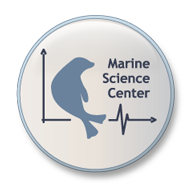Research
For humans it is almost impossible to orient themselves in the marine environment without technical equipment because underwater vision is often restricted due to darkness and turbidity and above water, when offshore, there do not seem to be many cues available for a successful orientation - at first glance. In contrast marine mammals are well orientated. They are able to locate foraging grounds and sites of reproduction, undertake seasonal migrations as well as return to haul out places precisely. The basis of these orientation abilities of marine mammals such as seals, toothed and baleen whales, manatees, and otters have been the scientific focus of zoologists and engineers for a long time. However up to now not much is known about the information these animals use for small and large scale navigation. On the one hand this is due to the fact that the underwater world is still hardly accessible and that experimental work with wild animals in their habitat is difficult. On the other hand the sensory abilities of these animals were investigated primarily under laboratory conditions so far, and sensory adaptations to the aquatic environment were interpreted in comparison to the performance and function of sensory systems of terrestrial mammals. Furthermore, scientists have missed so far to look at orientation in the aquatic environment as a multimodal controlled cognitive process.
The aim of our scientific work is to investigate already known orientation mechanisms as well as to unravel information channels available in the marine environment which were so far neglected. In the end we hope to obtain a complete picture of all the mechanisms used by marine mammals for orientation.


